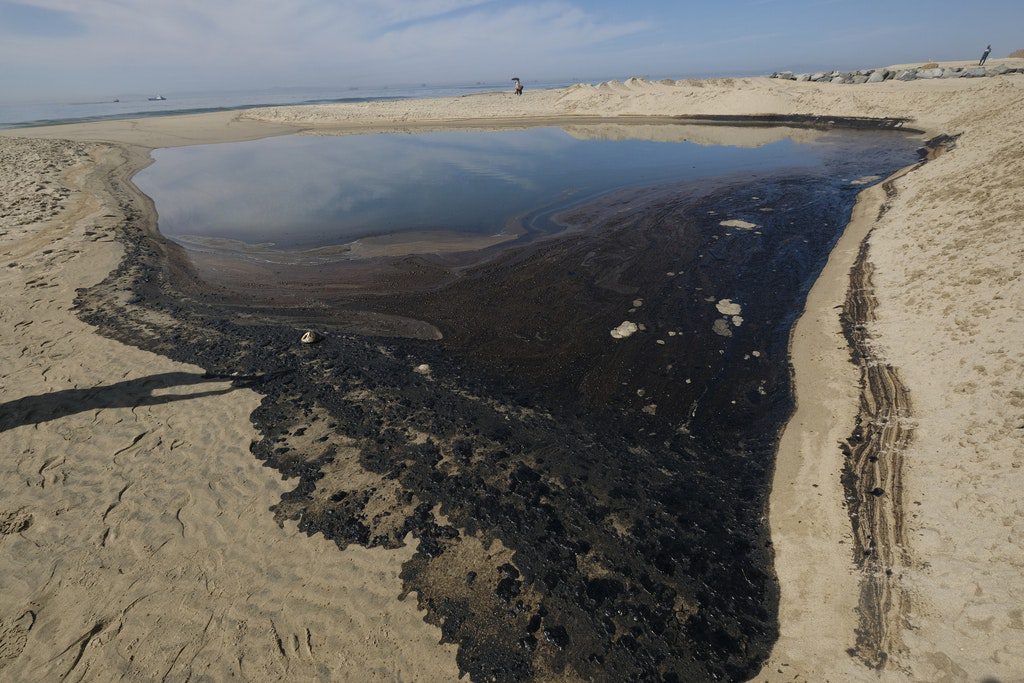(NBC) A 13-square-mile oil spill off the coast of Southern California forced officials to close beaches and warn of an ecological disaster Sunday as a previous plan produced by the operator of an offshore oil pipeline described such a situation as a “worst case” scenario that could cause “substantial harm.”
An offshore oil pipeline that was being investigated as the potential source for the 126,000-gallon leak off Newport Beach has been shut down and suctioned, said Martyn Willsher, chief executive of Amplify Energy, which owns the company that operates the pipeline.
A 2012 plan prepared by Beta Offshore and obtained by NBC News said that a full cut in the pipeline three miles from shore could release roughly 3,000 barrels, or 126,000 gallons, of oil.
Such a leak could cause “significant and substantial harm to the environment” because “of its proximity to navigable waters and adjoining shoreline areas designated as environmentally sensitive.”
Officials said Sunday that approximately 3,150 gallons of oil have been recovered from the water as divers were investigating a potential source of the leak roughly four miles from shore, the chief executive of Beta Offshore’s parent company, Amplify Energy, said.
Amplify Energy did not immediately respond to a request for comment on the 2012 plan.
The company’s chief executive, Martyn Willsher, said at a news conference Sunday that the pipeline had been shut down and suctioned. But local officials said the damage may have already been done.
“We’ve started to find dead birds & fish washing up on the shore,” Orange County Supervisor Katrina Foley tweeted.
Yet only one animal was officially confirmed to have been injured in the spill, a duck found covered in oil, said a spokesman for the California Department of Fish and Wildlife. Other reports of dead and injured wildlife were being investigated, he said.
Late Sunday, the department declared a fishery closure roughly 35 miles along the coast and out to six miles offshore.
Foley said she visited the area Sunday and felt the sting of vapor in the air.
“My throat hurt,” she said at a news conference.
Foley described seeing small clusters of oil along the shoreline that she compared to egg yolk. She pleaded with residents to stay away from the area and not disturb the oil clumps.
County health officials warned residents to be aware of dizziness, headaches and other side effects that exposure to an oil spill can cause. Some sections of the coastline in Huntington Beach were closed Sunday, and the city said in a statement that the spill had “substantial ecological impacts” on the shoreline and wetlands.
The spill forced the city to cancel the final day of its Pacific Airshow because, and skimming equipment and booms were deployed to prevent the flow of oil into ecologically sensitive areas, it said in a statement. Rep. Michelle Steel, whose district includes Huntington Beach and Newport Beach, asked President Joe Biden to declare a major disaster to help with recovery efforts.
Miyoko Sakashita, director of the Center for Biological Diversity’s oceans program, said the spill was a tragic reminder of the devastating threat offshore drilling can pose.
“I’ve seen the aging oil platforms off Huntington Beach up close, and I know it’s past time to decommission these time bombs,” she said. “Even after fines and criminal charges, the oil industry is still spilling and leaking into California’s coastal waters because these companies just aren’t capable of operating safely.”
Californians have been particularly wary of offshore oil spills since the disastrous leak off the coast of Santa Barbara in 1969, when images of birds and other wildlife covered in heavy black gunk helped spark the modern environmental movement.
Willsher said the pipeline is connected to a processing platform — one of three in the area owned by Houston-based Amplify Energy — is 17.5 miles off the coast. They were built in the 1970s and ‘80s and the company has owned them for nine years, he said.
The pipeline is inspected every other year and has been “meticulously maintained,” he said, adding that the most recent inspection occurred last week. The pipeline’s capacity is 126,000 gallons, and Willsher said he did not expect any more leakage.



